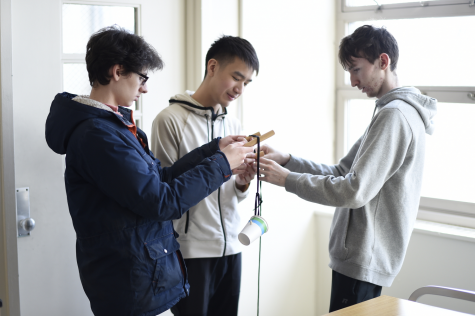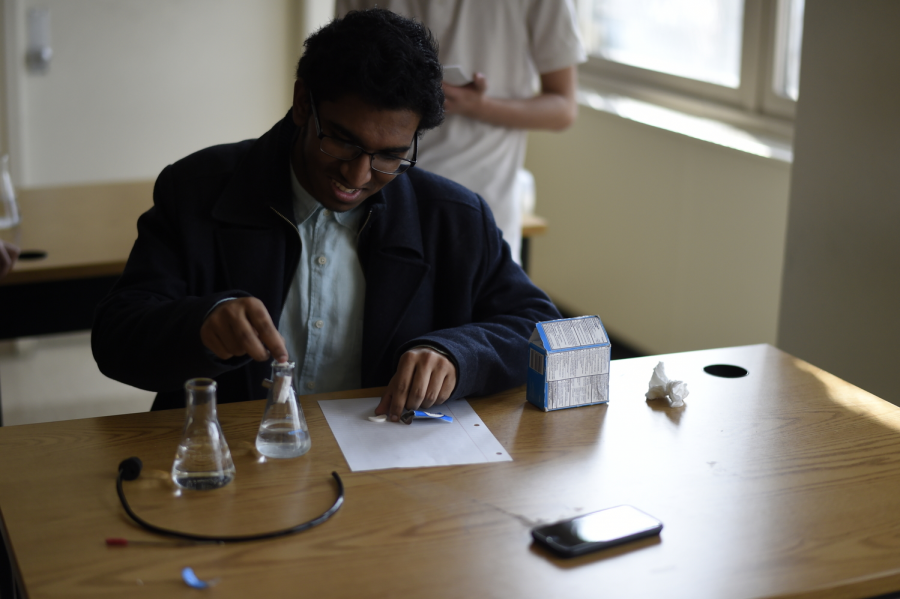Exploring the World of Science Olympiad
Dion Sukhram ’19 puts together a device where alka-seltzer would be used to push a golf ball off a ramp for the event Mission Possible.
For the second year in a row, the Science Olympiad has qualified for the state competition after placing seventh out of nearly fifty schools at a regional competition.
In preparation for their upcoming regional competition on February 2nd at Grover Cleveland High School, the members prepared tirelessly for their respective events, either academic or building. Bearing the fruits of their labor, William Chen ’19, David Guo ’19, Aaron Shtilerman ’20, Michael Heege ’19, Kevin Zheng ’20, Yea Won Lee ’19, Dion Sukhram ’19, Hector Wilson ’20, Abby Wu ‘20, and Wyatt Morgan ’20 received medals for their outstanding performances.
For academic events, students were given a topic that they had to prepare with a partner in order to perform well on the exam. Some topics included Anatomy & Physiology (A&P) and Disease Detectives (Epidemiology). Unlike typical tests where students are required to work without notes, the academic exams allowed students to utilize a “cheat sheet” to complete the packet of multiple choice and short response questions.
“My partner Hector and I competed and won a medal in the Anatomy and Physiology event. This year’s topics were the cardiovascular, lymphatic, and the excretory systems. Within each main topic, there were subtopics such as tissues, vessels, and even diseases,” said Abby Wu ’20. “With limited time and over 100 questions, we tore pages out of the packet and passed them to each other to make the process more efficient. A lot of the questions required us to apply our knowledge; simply memorizing would not work.”
David Guo ’19 and Kevin Zheng ’20 also believe that preparing for the test is a worthwhile experience, especially because the test requires students to study material from previous competitions and do research using online resources.
Guo specified that for the Disease Detectives, an event that was particularly interesting to him, he and his partner studied a lot from the Centers for Disease Control and Prevention (CDC) website. “It directs one to think like an epidemiologist who is studying an outbreak of a disease and determining how to stop it, rather than a student just taking a test,” said Guo. “The competition in general encourages cooperation and division of labor. Because everyone has a partner, we often study different things so we can cover as much knowledge as possible,” he added.
“With more of a cohesive team effort put into each event, the team had more of an established base which really gave us the edge,” said Tahmid Ahmed ’19.
Along with the academic events, other members were assigned to build a project for their respective category. One specific build event, Sounds of Music, required students to create an original instrument that could play a major scale. “For this event, I created an idiophone, an instrument that vibrates at its natural frequency when struck.The event was scored by pitch accuracy and volume in decibels, and is based on the physics of sound,” said build manager Beatrice Arana ’19. The process was no easy feat, as it required precision and attention to detail. Continual errors were made during the design and construction, but through this, the final product was in its most flawless form.

Daniel Belkin ’23, David Guo ’19 and Michael Heege ’19 ensure that their project is ready for the build event Boomilever.
Likewise, students in Wright Stuff, a different build event, had to build a wooden model aircraft powered by a rubber band in order for it to fly for the longest time. “The preparation process was time-consuming and challenging, but satisfying in the end. We started by designing and planning the project before constructing an initial model. We then evaluated its flaws and altered the design for the final product,” said Guo.
The team’s success in these events can be attributed to the leadership of co-captains Sakshi Shah ’19 and Tahmid Ahmed ’19 who approached their roles in a unique manner. “I think that our new divisions of labor and setting clear goals of what exactly we are looking forward to are what helped us prosper the most,” said Shah.
“With more of a cohesive team effort put into each event, the team had more of an established base which really gave us the edge,” said Ahmed.
With their aspirations in mind, the team expressed their desires to expand their outreach within Bronx Science and further their success in the upcoming years. Science Olympiad is more than just a team. The mindset to explore and represent what the team stands for propels these students to satisfy their curiosity, discover new knowledge, and fulfill the mission of being a scientist. “I want for people at Bronx Science to know about the Science Olympiad team and what we stand for and represent,” said Shah.
Hyein Lee is a Managing Editor/Advisory Editor for ‘The Science Survey’ and a Student Life Section Reporter for ‘The Observatory.’ She finds journalistic...











